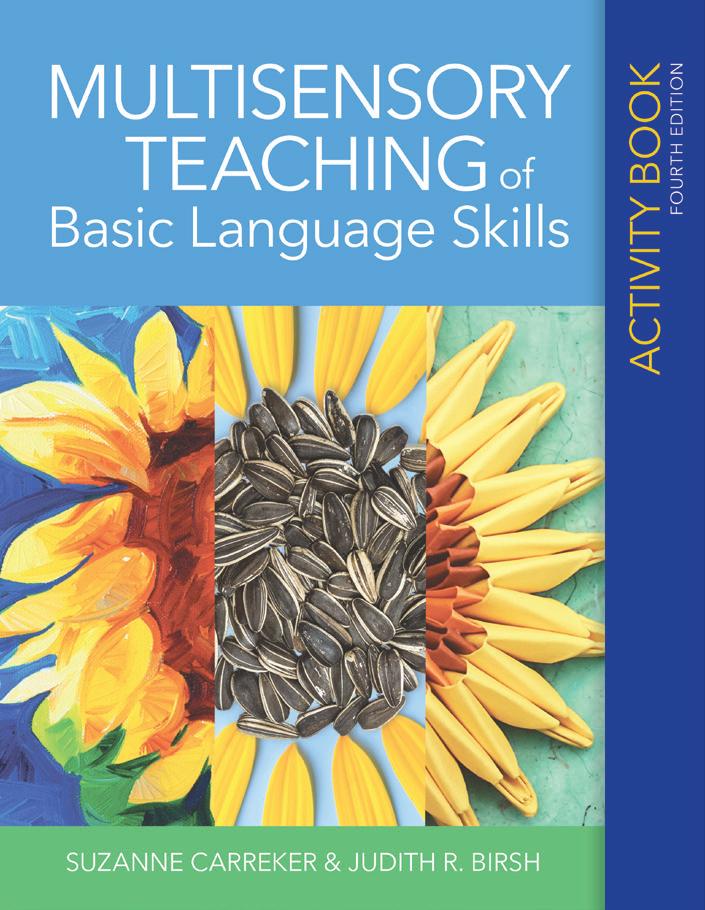
2 minute read
Fluency Assessment



Multisensory Teaching of Basic Language Skills
Fourth Edition
BOOK edited by Judith R. Birsh, Ed.D., CALT-QI (independent literacy consultant), & Suzanne Carreker, Ph.D., CALT-QI (Lexia Learning Systems) ACTIVITY BOOK by Suzanne Carreker, Ph.D., CALT-QI, & Judith R. Birsh, Ed.D., CALT-QI
Listed by the 2020 National Council on Teacher Quality’s Teacher Prep Review as an exemplary text With the fourth editions of this bestselling textbook and activity book, you’ll fully prepare a new generation of educators to use the highly respected multisensory teaching approach to literacy. covering all five elements In the textbook—the most comprehensive of effective reading text available on multisensory teaching—instruction. your students will get timely new information on using multisensory literacy approaches effectively with K–12 students who have dyslexia and other learning disabilities. Updates include: • New chapters on prekindergarten literacy, executive function, and math learning disabilities • Content aligned with the 2018 IDA Knowledge and Practice
Standards for Teachers of Reading; prepares students for the
IDA certification exam • The latest research in the field • New insights and guidance on technology • Online companion materials and resources • More student-friendly features, including learning objectives, reflection questions, and new case studies In the activity book, your students will get more than 100 activities that boost their knowledge in all the areas covered in the textbook. The updated edition includes NEW activities on executive function, prekindergarten literacy, and math learning disabilities.
Book—US$84.95 | Stock #: 52261 | 2019 | 920 pages | 7 x 10 | hardcover | ISBN 978-1-68125-226-1 Activity book—US$34.95 | Stock #: 53084 | 2019 | 192 pages | 8 ½ x 11 | layflat paperback | ISBN 978-1-68125-308-4
ORDER EXAM COPY
BOOK CONTENTS
1. Connecting Research and Practice 2. Structured Literacy Instruction 3. Oral Language Development and Its Relationship to
Literacy 4. Pre-Kindergarten Literacy 5. Alphabet Knowledge: Letter Recognition, Letter
Naming, and Letter Sequencing 6. Teaching Phonemic Awareness 7. Assessment of Reading Skills: A Review of Select Key
Ideas and Best Practices 8. The Role of Executive Function in Literacy Instruction 9. Teaching Reading: Accurate Decoding 10. Teaching Spelling 11. Multi-Modal Handwriting Instruction for Pencil and
Technology Tools 12. Fluency in Learning to Read: Conceptions,
Misconceptions, Learning Disabilities, and
Instructional Moves 13. Math Learning Disabilities 14. The History and Structure of Written English 15. Working with Word Meaning: Vocabulary Instruction 16. Strategies to Improve Reading Comprehension in the Multisensory Classroom 17. Composition: Evidence-Based Instruction 18. Designing the Learning Environment and Planning
Multisensory Structured Literacy Lessons 19. Language and Literacy Development Among English
Language Learners 20. Instruction for Older Students with a Word-Level
Reading Disability 21. Working with High-Functioning Adults with Dyslexia and Other Academic Challenges






